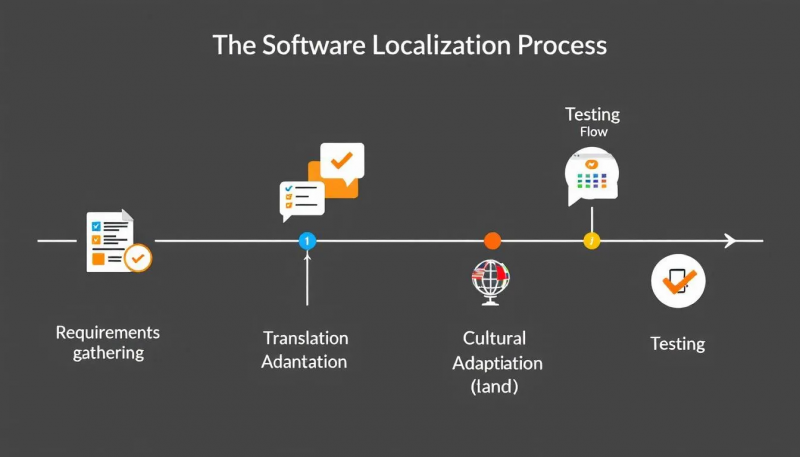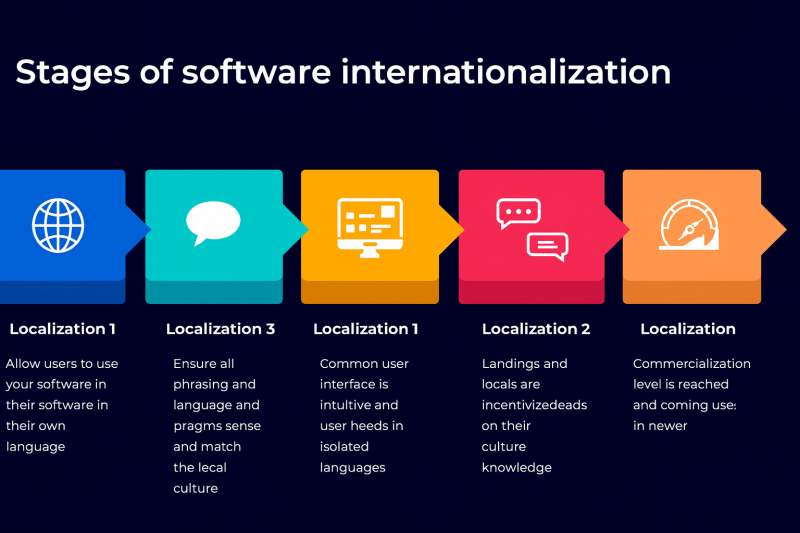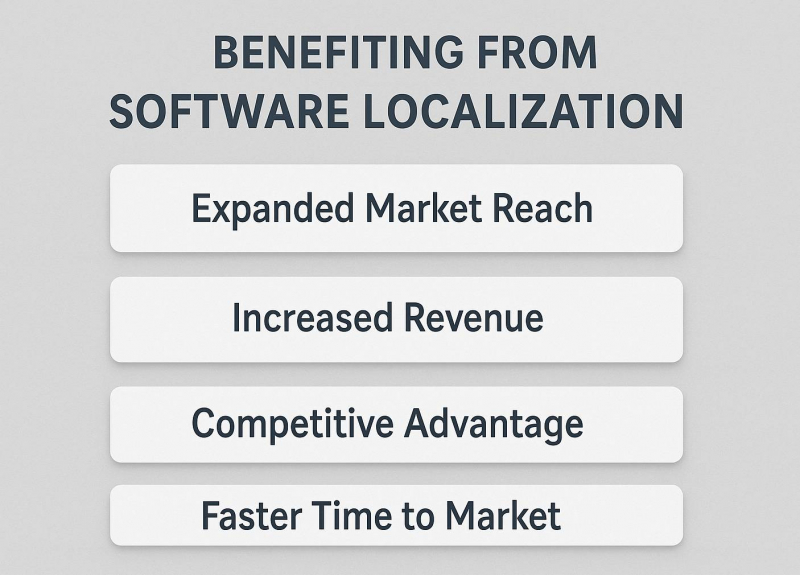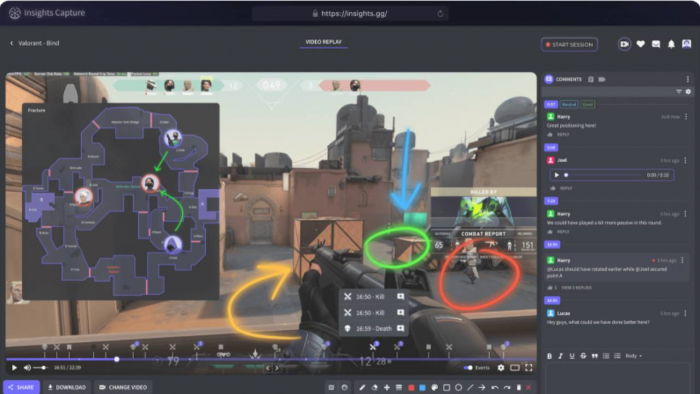Is your software ready for the global stage? True localization is about adapting to languages and cultures, not just translation. This article will guide you through the key steps and strategies for effective software localization.
Key Takeaways
- A typical software localization process involves adapting software for different languages and cultures, improving user experience and market reach.
- Key processes include internationalization, localization, and translation, which work together to ensure software is culturally relevant and easily adapted for various markets.
- Implementing best practices such as using separate resource files, managing code for multiple languages, and conducting quality assurance are essential for successful software localization.
Understanding Software Localization

Software localization is more than just translating text from one language to another; it is the process of adapting software for different languages and cultures. This complex process involves modifying the user interface, ensuring cultural relevance, and addressing local regulations and conventions. Localizing software enables businesses to expand market reach, enhance customer satisfaction, and build trust and loyalty among users.
Effective localization not only improves user experience but also differentiates a brand in competitive markets. Providing software in users’ native language reduces communication barriers for native speakers, increases engagement, and drives higher conversion rates.
Ignoring localization, on the other hand, can lead to uninstalls and damage a brand’s reputation, highlighting the critical role of this process in today’s global marketplace.
Preparing for Software Localization
The initial step in the software localization process is internationalization (i18n), which involves designing the software to support multiple languages and cultural contexts from the outset. This preparation is crucial for successful software localization. One of the first tasks is to set up source language files in version control repositories, such as:
- Azure Repos
- GitHub
- GitLab
- Bitbucket This ensures that all translatable text is stored efficiently.
Automation plays a significant role in streamlining the localization process. By using a CLI tool, files can be uploaded with a single command line, simplifying the workflow. Additionally, file formats such as JSON, YAML, and XLIFF are commonly used for separate resource files, facilitating efficient localization.
Testing for localization challenges compatibility early in the development process can help identify potential issues before they escalate, ensuring a smoother localization journey.
Implementing Internationalization

Implementing internationalization involves:
- Designing the software to facilitate future localization for different cultural contexts.
- Using placeholders in the code to allow dynamic content to adapt based on the selected language.
- Defining a full locale, which includes both language and country codes, to ensure the software can handle regional variations effectively.
Using UTF-8 character encoding is essential as it supports a wide range of characters, preventing translation issues related to character corruption. Additionally, employing version control systems aids in tracking changes to internationalized codebases, making it easier to manage updates and revisions.
Laying a solid foundation with internationalized software ensures that internationalized software is ready for efficient and effective localization.
Effective Approaches to Localizing Software
Choosing the right approach to software localization is crucial for meeting project requirements and objectives. Implementing a modular architecture allows for easier updates to localized content.
The main models for localizing software include Waterfall Localization, Agile Localization, and Continuous Localization, each with its own set of advantages and challenges.
Waterfall Localization
Waterfall Localization assumes that all requirements are known upfront, which can limit flexibility and adaptability throughout the localization process. In this model:
- Translation typically occurs at the end of the development process, often causing delays in launching localized versions.
- Once the translated text is finisched, the next step is to manually upload the translated software strings.
- This process is done for the purpose of merging and publishing.
While this approach can be effective for projects with well-defined requirements and timelines, its rigidity can be a drawback in dynamic and fast-paced development environments. The lack of flexibility to accommodate changes can lead to inefficiencies and increased time-to-market for localized software versions.
Agile Localization
Agile Localization integrates localization directly into the development cycle, allowing for more responsive content updates and greater flexibility. This approach increases efficiency and allows for continuous updates of software content, making it ideal for dynamic environments where requirements may change frequently. However, it can be more complex and may require dedicated localization engineers to manage the workflow effectively, utilizing agile localization practices.
By synchronizing localization with development processes, Agile Localization ensures that localized content is always up-to-date and ready for release. This method is particularly beneficial for projects that require frequent updates and fast turnaround times.
Continuous Localization
Continuous Localization is an extension of Agile Localization that keeps software content updated in multiple languages at all times. This approach is designed to integrate fully with development practices, ensuring that content is always ready for release in multiple languages. Crowdin’s continuous localization practices approach, for example, allows updates to flow naturally into the translation pipeline without disrupting development cycles.
Leveraging tools like Crowdin streamlines the translation process, automating the presentation of new strings for translation and minimizing manual tasks. Continuous Localization is ideal for projects that require constant updates and aim to deliver high-quality multilingual products quickly and efficiently.
Best Practices for Software Localization
Adopting best practices in software localization can significantly enhance the efficiency and effectiveness of the localization process. Key practices include using separate resource files, managing code for multiple languages, and designing for text expansion.
These practices ensure that the software application can be easily adapted to different languages and cultural contexts, providing a seamlessly integrated user experience.
Separate Resource Files
Streamlining localization requires keeping all translatable text in external resource files rather than embedding it directly in the code. Using separate resource files allows for easier management of localizable elements and ensures that the localization process is more efficient.
Be specific with locale when creating particular language files to ensure effective localization.
Manage Code for Multiple Languages
Managing code for multiple languages involves designing software that can dynamically adapt content based on the user’s language preference. Using placeholders in the source code allows for the insertion of dynamic content, ensuring that the correct translation is displayed depending on the selected language. This approach streamlines the localization process and enhances the user experience.
Design for Text Expansion
Designing for text expansion is vital as different languages can require significantly varying amounts of space, impacting the overall UI layout. It’s important to prepare your user interface for varying string lengths, as formatting differences can differ significantly in size.
Accommodating text expansion ensures that the user interface remains functional and aesthetically pleasing across dialog boxes and different languages.
Cultural Adaptation and Visual Elements
Cultural adaptation entails more than just language translation; it involves adapting software to consider cultural norms and nuances, ensuring that the software resonates with the target audience. This process includes modifying content to align with local customs, social norms, and visual preferences. Understanding local holidays and traditions can influence design and content choices, making the software more relevant and engaging for users.
Visual elements play a significant role in cultural differences adaptation. Color meanings, cultural references in visuals, and design elements can vary greatly between cultures. For instance, consumers in Japan tend to favor more detailed and cluttered designs, while other markets may prefer minimalist layouts. Adapting visual elements to match cultural expectations enhances user experience and builds stronger connections with the audience.
Utilizing a Software Localization Tool
A software localization tool, such as Crowdin, can significantly streamline the localization process by centralizing workflows and enhancing collaboration between developers, translators, and project managers. Crowdin provides:
- An intuitive editor where translators can work collaboratively
- Support from Translation Memory
- Glossaries
- Machine Translation engines
This centralized approach ensures that every step of the localization process is efficient and well-coordinated.
Crowdin also integrates seamlessly with code repositories like GitHub, GitLab, and Bitbucket, as well as popular project management tools, ensuring that no content is missed during updates. Automating manual tasks with Crowdin enables teams to focus on quality and speed, delivering high-quality multilingual products faster and more reliably.
Ensuring Quality Assurance in Localization
Quality assurance is crucial in localization to ensure that translated content meets both linguistic and functional standards. A robust testing and QA process should be integrated from the start to effectively gauge quality throughout the localization process.
Both automated and human review processes play essential roles in maintaining the quality and cultural relevance of both the culture of localized software.
Automated Testing Tools
Automated testing can help detect issues such as untranslated segments and inconsistencies in layout, ensuring high-quality localized versions. Tools like Crowdin enable reviewers to proofread translations within the platform, while developers see real-time previews through in-context translation tools, enhancing the overall quality and efficiency of the localization process and providing accurate translation.
Human Review Processes
Human reviewers provide insights that automated systems may overlook, ensuring translations are culturally relevant and contextually accurate. Providing context notes alongside translatable strings can significantly aid translators in understanding the intended usage and meaning, further enhancing the quality of localized software.
Cost Considerations in Software Localization
Localization costs encompass not just translation but also project management, marketing, customer support, and technical considerations. Factors influencing localization costs include software size, complexity, and target languages, which shape the final pricing.
Translation Memory (TM) helps reduce costs by allowing the reuse of previously translated segments, making the process more efficient and cost-effective. A translation management system can further enhance this efficiency. Repetitive content can lead to cost savings, as it is often charged at a lower rate.
Additionally, the complexity of programming files can lead to variable costs for localization engineering, and the availability of professional translators in a region can significantly affect translation costs. Understanding these cost factors and software localization challenges can help businesses manage their localization budgets more effectively and achieve successful software localization.
Measuring ROI of Localization Efforts
Measuring the return on investment (ROI) of localization efforts is essential to understand the impact on business growth. The ROI can be expressed as a formula: [(Current added value of localization - Cost of localization) / Cost of localization] * 100. Tracking revenue generated from localization requires pre-project revenue forecasts and post-implementation market data comparisons. Revenue gained from localization is influenced by several factors. These include new user sign-ups, upgrades, and conversions from local markets.
Successful localization can lead to significant increases in downloads and user engagement, with companies achieving ROI between 140% and 3000%. For example, spending $20,000 on German software localization resulted in $80,000 in revenue, demonstrating the substantial financial benefits of effective localization efforts.

Industries Benefiting from Software Localization
Software localization plays a crucial role in helping various industries meet global demands and engage local audiences. Examples include:
- Healthcare: Accurately translating medical documents and ensuring compliance with local regulations.
- Entertainment: Utilizing localization for subtitling and dubbing to maintain viewer engagement across diverse cultures.
- Netflix: Expanding its global audience significantly by providing subtitles and dubbing in various languages.
Software and technology companies must localize user interfaces and documentation to effectively communicate with users from different local market. Platforms like Airbnb and Spotify have successfully localized their content using a localization platform to cater to regional tastes and enhance user engagement.
The education sector also benefits from localization by adapting eLearning content to align with the cultural context and language of students in different regions. Overall, effective software localization enables industries to thrive in international markets and build strong connections with local audiences.
Case Studies of Successful Software Localization
Many companies have set the bar high for software localization, showcasing the significant impact it can have on global reach and user satisfaction. For instance, Microsoft invests heavily in localization to ensure its software products meet the specific needs and preferences of users in different countries. Hiring local teams, using advanced Translation Management Systems (TMS), and continuously testing for quality and context help these companies achieve greater market penetration and improved user engagement through software localization services.
Another notable example is Facebook, which employs a collaborative translation model that allows users to contribute to the localization of its platform. This approach fosters community ownership and engagement, enhancing the user experience across different languages and cultures.
These case studies demonstrate that effective localization leads to higher ROI and sets a strong foundation for global market business success.
Summary
In conclusion, mastering the software localization process is essential for businesses aiming to expand their global reach and enhance user satisfaction. By understanding the differences between translation, localization, and internationalization, and implementing best practices, companies can create software that resonates with diverse audiences. Effective approaches such as Agile and Continuous Localization, along with the use of advanced tools like Crowdin, streamline the localization process and ensure high-quality outcomes.
Investing in quality assurance, managing costs, and measuring ROI are crucial steps in achieving successful software localization. Various industries, from healthcare to entertainment, benefit significantly from localization efforts, as demonstrated by numerous case studies. By embracing localization, businesses can build strong connections with local markets, drive growth, and achieve long-term success in the global marketplace.
Frequently Asked Questions
What is the difference between translation and localization?
Translation is the process of converting text from one language to another, whereas localization involves adapting the content and functionality of a product to meet the cultural and contextual needs of a specific market.
Why is internationalization important in the localization process?
Internationalization is crucial in the localization process because it ensures that software is designed to accommodate multiple languages and cultural contexts, thereby facilitating efficient and seamless future localization efforts.
What are the benefits of using a software localization tool like Crowdin?
Utilizing a software localization tool like Crowdin significantly improves workflow efficiency and encourages team collaboration while automating manual processes. This ultimately leads to high-quality localization results.
How can businesses measure the ROI of their localization efforts?
To effectively measure the ROI of localization efforts, businesses should track revenue generated post-localization against pre-project forecasts and apply the ROI formula to quantify the financial return. This method provides clear insights into the impact of localization on market performance.
Which industries benefit the most from software localization?
Industries such as healthcare, entertainment, technology, e-commerce, and education significantly benefit from software localization, as it allows them to meet global demands and better engage local audiences.
Post Comment
Be the first to post comment!





